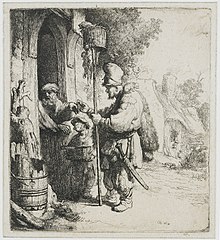Rat poison seller
Rat poison seller refers to a historic ambulatory trader who offered poison for rat control .
job profile
The fast-growing, poorly canalized and developed cities and municipalities offered an ever-increasing habitat for house rats in the early modern era. The rat catchers, which had been working with their slap and choke traps since the Middle Ages, were too ineffective. From the end of the 16th century, a licensed rat poison trade developed in Dutch cities . Numerous prints and genre pictures from the second half of the 16th to the end of the 19th century show the stereotype of the rat poison seller who advertises his arsenic-based poison portions with a basket of dead and live tamed rats attached to a pole . Illustrations of ambulatory rat poison sellers appeared in Italy in the late 16th century and in the Netherlands since the early 17th century . From there they spread to Germany and France .
Independent of this, there are also depictions of rat poison sellers on Japanese woodcuts from the 18th and 19th centuries.
Social status of the rat poison sellers
The rat poison sellers were at the lowest level of society. According to the Amsterdam city ordinances of 1595 and 1613, they were treated as beggars. Their low social status remained until the 19th century.
End of the profession
At the end of the 19th century at the latest, the rat poison seller disappeared from the streets of Europe, as he could no longer fight off competition from spice dealers and druggists. The arsenic-containing goods also fell into disrepute due to the increasing use as inheritance powder or poisonous meal and required a controlled sale .
In France, on October 29, 1846, an arsenic regulation was published in the Moniteur. According to Section 9, rat poison containing arsenic was pharmacy-only from this point in time. The sale was only allowed to registered buyers with a permanent address. As a result, the Pharmacie de Paris developed a safety rat poison that made it difficult to add to human food in terms of color and taste.
German travel reports from 1864 and word for word from 1872 describe a peddling Parisian rat poison dealer who has a dozen dead rats and a poster with the inscription: "Pas de Prison, guerre implacable aux rats" attached to a pole.
Rat poison sellers in the fine arts
16th Century
On a copper engraving based on a drawing by Annibale Carracci , published posthumously only in 1646, Italian rat poison sellers contented themselves with rats painted on a flag for their product advertising.
17th century
The etching of the same name by Rembrandt from 1632 is a very early depiction of a rat poison seller, which is important because of its technique. It was copied eleven times in the 17th century alone. Jan van Vliet, Abraham Bosse , David Teniers the Younger and Cornelis Visscher, who stabbed an Amsterdam and Harlem rat poison seller in 1655 , produced independent works .
18th century
Representations of the rat poison seller were also popular in the 18th century, even if the later depictions may only cite Rembrandt. The subject can be found, among others, with Johann Georg Wille , Johann Georg Trautmann , repeatedly with Christian Wilhelm Ernst Dietrich , with Martin Johann Schmidt and most recently with Christian von Mechel , whereby Mechel reproduces Willes' original in his black-humored paper on the wedding of Felix Nüscheler.
19th century
In the 19th century, the rat poison seller only appears in commercial graphics as the Marchand-Mort-aux-rats of the lithographed calls for merchandise or in book illustrations. For the story La Mort de Jeannot: les frais du culte, avec quatre dessins de Gustave Courbet: exposition de Gand de 1868 (1868), Gustave Courbet created the drawing of the rat poison seller Jeannot, Marchand de Mort-aux-rats in 1867/68 . The sheet was shown from June 3 to August 6, 1989 in a Courbest exhibition at the Bridgestone Museum of Art, Ishibashi Foundation, Tokyo.
Charles-Joseph Traviès published in Caricature No. 213 of December 4, 1834, the caricature of the rat poison seller in politics, the La Mort-aux-rats politiques .
literature
- Guy Devaux: Marchands de mort-aux-rats. In: Revue d'histoire de la Pharmacie. Vol. 92, No. 343, 2004, pp. 509-516. (online at: persee.fr )
- Polyxeni Potter: Rats, Global Poverty, and paying the Piper. In: Art in Science: Selections from EMERGING INFECTIOUS DISEASES. Emerging Infectious Diseases, Vol. 13, No. 10, October 2007, p. 192. (online at: wwwnc.cdc.gov )
Individual evidence
- ↑ Disinfection and Healthcare. Volumes 47-49, 1955, p. 421.
- ↑ Cf. Franziska Ehmcke, Chantal Weber, Antje Lehmberg: Japan seen again and again: Perspectives on Japanese research at the University of Cologne. LIT Verlag, Münster 2013, p. 111.
- ↑ Rembrandt and his Competitors, Międzynarodowe Centrum Kultury, 2006, p. 32.
- ↑ Cf. Ingo Wirth, Andreas Schmeling : Forensic Medicine: Basic Knowledge for Investigative Practice. Hüthig Jehle Rehm, 2012, p. 200.
- ↑ Guy Devaux: Marchands de mort-aux-rats. In: Revue d'histoire de la Pharmacie. Vol. 92, No. 343, 2004, pp. 509-516.
- ^ Hermann Adalbert Daniel: Handbook of Geography. Volume 2, Verlag für Kunst und Wissenschaft, 1872, p. 490.
- ↑ See the original Carracci drawing from the Louvre collection (online at: culture.gouv.fr )
- ^ Hermann Mildenberger: Rembrandts Etchings. Inventory catalog: Former Grand Ducal and State Collections as well as Goethe's Collection. Böhlau Verlag, Cologne / Weimar 2011, p. 40.
- ↑ See street vendors in pictures by Dutch artists. In: Arbeitskreis Bild Druck Papier - proceedings Berlin 2012, edited by Konrad Vanja, Detlef Lorenz, Alberto Milano, Sigrid Nagy, 2012, p. 81.
- ↑ Alexander Roob: Against Daumier. A revision of the early French cartoon movement and social graphics. 2008, online Melton Prior Institute


